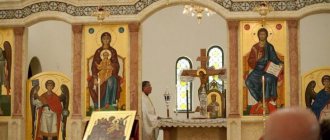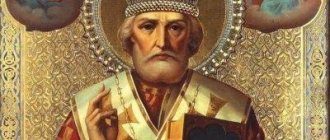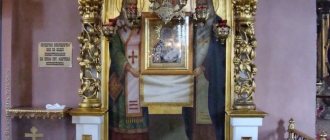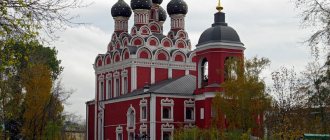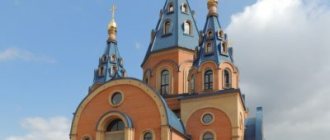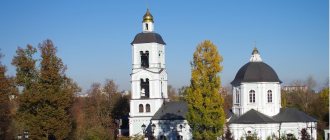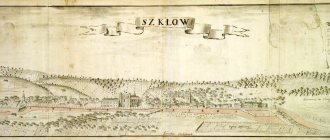Ancient icons of the Intercession Cathedral in Rogozhskaya Sloboda
The Intercession Cathedral was built in 1792 according to the design of the outstanding Russian architect Matfei Kazakov and is a rectangular building made in the style of Russian classicism, topped with a rotunda with a dome and a cross. The height of the dome is 43 meters.
The inside of the temple is painted by Palekh masters who worked on the frescoes for more than 10 years.
The main and main shrines of the temple are icons. The temple contains more than 1,500 icons of ancient Byzantine writing from various schools of painting that existed in Rus' between the 15th and 18th centuries.
The five-tiered iconostasis of the cathedral contains 318 icons, selected and donated from various churches and prayer houses, as well as from personal collections of Old Believers.
|
|
|
|
To the right of the royal doors in the lower tier there is an icon with a half-length image of the Savior from the Deesis rite of the 15th century. Andrei Rublev's school.
A kind of “calling card” of the temple is the chandelier, unique in size for that era, weighing 3 tons (bronze, silver, gold), which is illuminated by wax candles on the Twelfth and other great holiday services.
Chandelier in the Church of the Intercession on Rogozhsky
No less unique is the wooden staircase, which is as old as the temple. Along the edges of the supporting pillars of the temple there are church banners - banners, a gift from the Old Believer communities to the Rogozh community in commemoration of the opening of the holy altars in 1905.
In the temple there is a locally revered icon of the Tikhvin Mother of God. According to established tradition, this icon is venerated before the sacrament of communion. On the left behind the glass are the most ancient icons of the temple, for example, St. Paraskovia Friday XIV century. Novgorod letters.
Saint Parascovia Friday. Late XIV - early XV centuries.
In the Church of the Intercession there are almost no icons that were painted specifically for it. Mostly, icons were donated to the temple by pious parishioners and trustees of the temple.
Over the years, the trustees were the Ryabushinsky merchants, who donated many ancient images, including an icon with the “main” image of the Savior Emmanuel of the school of Andrei Rublev (15th century).
Icon with the “main” image of the Savior Emmanuel. Painting of Andrei Rublev's school of the first half of the 15th century
The gift of one of the most famous philanthropists of the mid-19th century. — Kozma Terentyevich Soldatenkov are icons of the Stroganov school of painting in the 17th century. Among the authors of the icons is the famous royal icon painter Nikita Pavlovets, who was accepted into the Armory in 1668. Here is his icon with a half-length depiction of St. St. Nicholas the Wonderworker, as well as a miniature with the life of St. Sergius of Radonezh. No less famous is the icon painter of the same Armory Chamber - Procopius Chirin. Here are his icons of the Savior on the throne with the fallen Macarius the Confessor and St. John the Martyr, and the Mother of God with the upcoming saints. Gregory the Theologian and St. much Nikita the warrior.
The Mother of God on the throne with Saints Gregory the Theologian, Nikita, Mavra and Eupraxia. Author Prokopiy Chirin
Great credit goes to the famous Moscow philanthropists of the mid-19th century for organizing the church life of the Old Believers. - merchants-Old Believers Rakhmanovs. Thanks to their charitable activities, schools were organized to study church singing and rules. Among the Rakhmanov collection of icons, “The Entry of the Lord into Jerusalem” from the beginning of the 14th century stands out. Novgorod letters.
At the holy altar on the right there is a rare icon of the Byzantine letter of the 14th century. “Savior is the ardent eye”, here is an icon of an unknown Greek icon painter of the 15th century. “The Savior is in charge.”
In the sacristy of the Church of the Intercession there is a unique collection of ancient priestly vestments, which, according to experts from the Moscow Kremlin museums, has no analogue in Russia today.
The further fate of the Bolshechencher Church
At first, a fire post was located in the church, and the ringing of the bells now became only a distress signal. Then the church had a granary, so the extra doors and windows were boarded up. They couldn’t remember where the bells were or who removed them.
Photo by: Anastasia Starikova
Crosses or a cross (we don’t remember how many there were) were on the church until 1963. They tried to remove them several times, but failed. At the request of local authorities (the chairman was then Grigory Tretyakov), in the spring of 1963, a resident of the village named after. Chelyuskintsev Andrei Fogel climbed onto the church, removed the cross and threw it to the ground. The reaction of residents in this regard was very negative. Andrei hanged himself in the fishing line closest to the church. What about the crosses? Forged crosses were thrown into scrap metal.
After the disaggregation of the state farm named after. Chelyuskintsev formed the Bolshechenchersky state farm. The director of the beginning state farm was Alexander Ivanovich Grigorov. In the spring of 1970, MTM was placed in the church premises. The church was completely destroyed, removing everything unnecessary, leaving only the main building. They couldn’t remove the domes for a long time; they pulled them with three tractors, then they sawed off the pillars from the inside, and only then they managed to throw them down to the ground. The domes lay for some time near the MTM - a former church, then disappeared somewhere.
MTM operated until the spring of 1980, then burned down. The cause was either careless handling of fire, a short circuit in the electrical wiring, or human error. But in general, it is a difficult coincidence of circumstances to explain. The first director of the state farm, Alexander Ivanovich Grigorov, died tragically (electrocuted in the city of Ishim during a business trip). The tractor driver who was removing the cross from the church, Danil Levchuk, died tragically (he, returning home in the winter during a storm, got lost, went far into the forest and froze), leaving four children. Maybe the death of these three people is connected with the sad history of the Bolshechencher Church, who knows...
The older generation was associated with the church. They remembered with love and regretted that this was the fate of this temple, which so adorned the village. This is their story, their life. In this church, many of them were baptized, got married, and held funeral services for their deceased relatives. They respected all this. The village residents told a lot about the temple: Voronina Matryona Grigorievna, Denisova Evdokia Andreevna, Sinitsyna Marfa Mikhailovna, Yurkova Fedosya Ivanovna, Lebedeva Yulia Konstantinovna.
The description uses materials from the Kazan Local History Museum named after. V. S. Arzhilovsky, story by A. R. Kezikov “From Ishim to Perekop.”
Author: Anna Trofimovna Degtyareva
The village of Bolshaya Chencher.
1998–2013
Photo: Anastasia Starikova
Order now!
Your ad could be here!
https://nashural.ru Your advertisement will be seen by thousands of people a day
Interesting? Tell your friends!
We need your help!
The Our Ural project existed for a long time using money from the sale of our books. Unfortunately, paper books are becoming less and less successful every year. If you want there to be a portal like “Our Ural” , please support us financially. Any help from you will be valuable, and from raindrops, streams are first formed, and then powerful rivers that flow into the seas. Thank you!
Interiors and shrines
According to ancient Russian tradition, the ceiling of a wooden church is made in the form of a “sky” - a gently sloping truncated pyramid. This is exactly how the ceilings were built in all the churches of the Russian North. Thanks to the unplastered walls and soft lighting, it is very cozy inside. There are benches for those who want to sit.
The altar Gospel, printed in 1701, is kept in the church. The shrines of the church are the Solovetsky Cross and the copy of the icon of the Intercession of the Blessed Virgin Mary, the original of which is kept in the Russian Museum of St. Petersburg.
Useful information for visitors
The Church of the Intercession is located on the territory of the Bogoslovka Estate museum complex and is one of the architectural objects of St. Petersburg that are under the protection of UNESCO.
The large historical and cultural complex of the wooden manor is still under construction (2019).
Bell tower
Here they plan to recreate the wooden churchyards that existed in the Vologda and Olonets provinces in the 17th-18th centuries. Soon visitors will be able to visit the Ethnographic Park, see wonderful examples of Russian wooden architecture and visit interesting museums.
The Pokrovsky Pogost complex is open daily. From October 1 to May 31 - from 10:00 to 17:00, from June 1 to September 30 - from 10:00 to 18:00. On Sundays and holidays – from 10:00 to 19:00. Every Saturday from 13:00 to 16:00 there are tours of the temple for tourists.
Entrance to the church is free. Divine services are held twice - in the morning and in the evening. The refectory and Sunday school are located on the ground floor. Near the gate there is a church shop that sells candles, icons and audio recordings of the church choir. There is a small cafe on the territory of the Pogost where you can try delicious pastries.
Revived Church
The project for the restoration of the architectural monument was prepared by the famous architect and restorer Alexander Viktorovich Opolovnikov.
In 1956, he took careful measurements and drew up detailed drawings so that lost parts could be restored and the wood paneling could be replaced. However, these developments lay unclaimed for almost 50 years.
The church began to be rebuilt in 2003 with the installation of the Worship Cross.
Selected Karelian forest was used for the building, which was harvested in the suburbs of Petrozavodsk.
The stones left over from the burnt Church of the Intercession were placed in the foundation of the church.
Construction work took 5 years and was completed in 2008. The solemn ceremony of consecrating the revived temple took place on October 14, the Feast of the Intercession of the Virgin Mary.
The new church became the architectural dominant of the “Pogost of the Church of the Intercession of the Blessed Virgin Mary” complex. Next to the temple there is a newly built bell tower, the Holy Gates, the Chapel of the Savior Not Made by Hands and a wooden fence.
From left to right: Chapel of the Savior Not Made by Hands, Church of the Intercession of the Blessed Virgin Mary, bell tower
How to get there
The church is located 5 km from the city. From the Lomonosovskaya metro station to the Bogoslovka Estate park you can take regular buses No. 476 and minibuses No. 476M. Public transport runs from 6:00 to 23:00 at intervals of 10-30 minutes.
Church domes
When a pier is built on the banks of the Neva, it will be possible to get to the temple complex by ships that run from the piers of St. Petersburg.
Attraction rating
Rating 3.50 [4 vote(s)]
| ← CATHEDRALS AND TEMPLES | SAINT PETERSBURG → |
Nevsky Forest Park
The green zone is located 5 km southeast of the city, so it is accessible to all residents of St. Petersburg. The picturesque forest area covers an area of more than 600 hectares. Spruce, pine, rowan, aspen, birch, larch and aspen trees grow in it. The Chernaya River flows through the forest park. At the entrance to the territory there is a stele dedicated to the sailors who died during the war.
The area on the right bank of the Neva looks well-groomed. The far part of the park is more like an overgrown forest, and several paths lead through it. In summer and autumn you can meet mushroom pickers here. In the depths of the park there is a spring that is used by summer residents.
During the Great Patriotic War, the Nevsky Forest Park was under intense artillery fire, so more than 90% of the trees were destroyed by fire and explosions. In the post-war years, the forest plantings were restored, and the park regained its beauty.
The Church of the Intercession stands in the western part of the forest park. In the 18th century, the Zinoviev estate Bogoslovka was located on this site. Several years ago, a beautiful two-story building and outbuildings were rebuilt.
